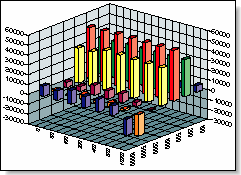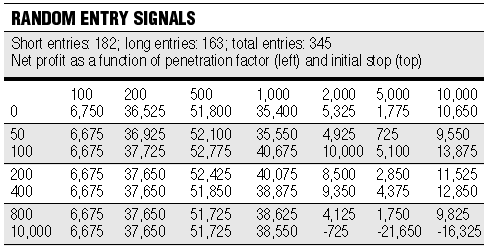MONEY MANAGEMENT
by Jeffrey Owen Katz, Ph.D., and Donna L. McCormick
A simple technical method for exiting a trade is the break of a trendline on a chart. This article measures the performance of using this strategy as an exit rule.
In recent articles, we explored the topic of exits and experimented to see whether the behavior of simple exit strategies could improve the performance of a system whose trade entries were essentially random. Our first exploration was of an exit strategy that involved a profit target exit, a stop-loss exit, and a time-based exit. Then we examined the behavior of trailing stops. In all instances, we used a standardized random entry system in which a random-number generator provided us with the entries into positions from which we could exit.
Thus far, we have found that a proper combination of even simple exit methods (for example, fixed?dollar amount stop-losses and profit targets) can substantially improve the behavior of a trading system -- even turning a random, losing system into a profitable one! We also learned that employing stop-losses and profit targets of the wrong sizes, or incorrect parameters for trailing stops, can ruin a trading system, making it perform significantly worse. Finally, although there is some interaction between the entry method and the behavior of the exit strategy, we discovered that there was also much similarity across entry methods in the behavior of the exits.
This time, we will continue our study of exit strategies by exploring a particular kind of barrier stop in the context of the same standardized, random-entry system.
WHAT ARE BARRIER STOPS?
A barrier stop is much like an ordinary stop-loss: It gets you out of a trade when the market moves against you. A barrier exit is taken when the market touches or penetrates some barrier, such as a point of support or resistance, a trendline, or a Fibonacci retracement level. Barrier exits represent theoretical barriers beyond which your interpretation of market action must be revised, and often they allow you to set very close stops, thereby dramatically reducing your losses on trades that go wrong. As is the case with trailing stops, and depending on the nature of the barrier, a barrier stop may be adjusted repeatedly as the trade progresses. When the barrier stops are based on trendlines, as is the case in this article, some of the paper profits that may accrue may be locked in if the market moves in the desired direction, similar to the way trailing stops perform.


FIGURE 1: NET PROFIT. This table shows the net profit as a function of the penetration factor. Regardless of the initial stop, the best penetration factor in this experiment was consistently $100. The best combination involved an initial money management stop of $500 with a $100 penetration factor; this yielded a profit of $52,775. The x-axis scale has been reversed for clearer viewing.
Jeffrey Owen Katz is a professional trader and consultant in Selden, NY. His firm, Scientific Consultant Services (516 696-3333), specializes in custom programming, provides expert consultation on systems development and the use of Omega Research's tools, and develops publicly available software for traders. Donna L. McCormick is a writer and vice president of Scientific Consultant Services.